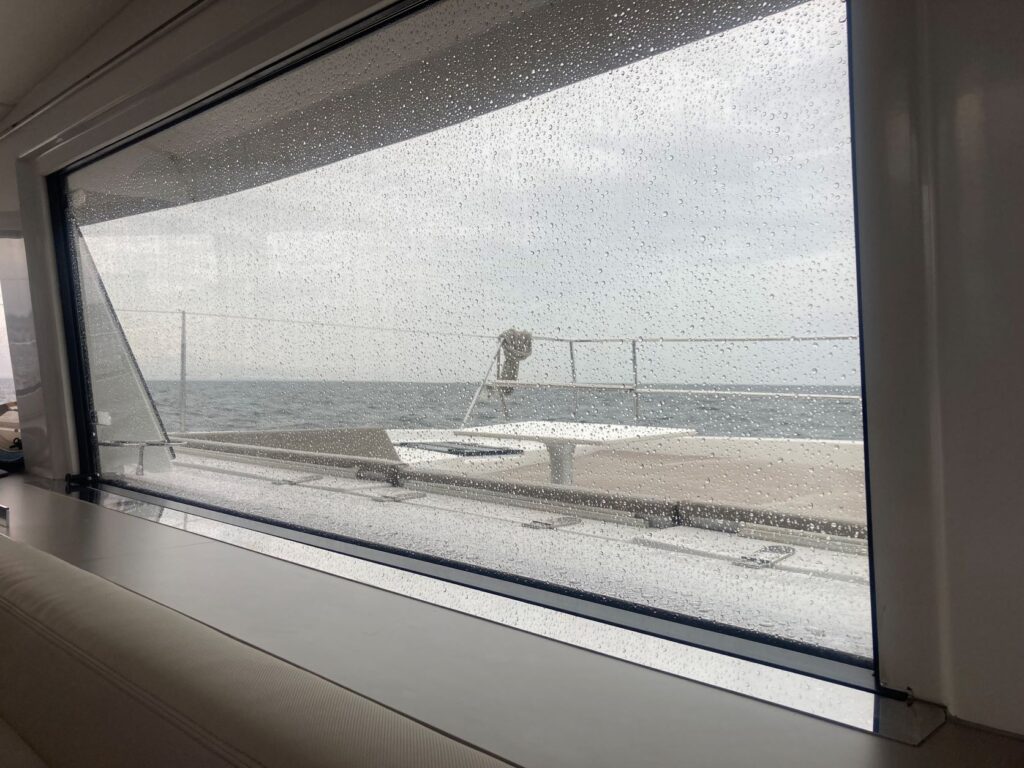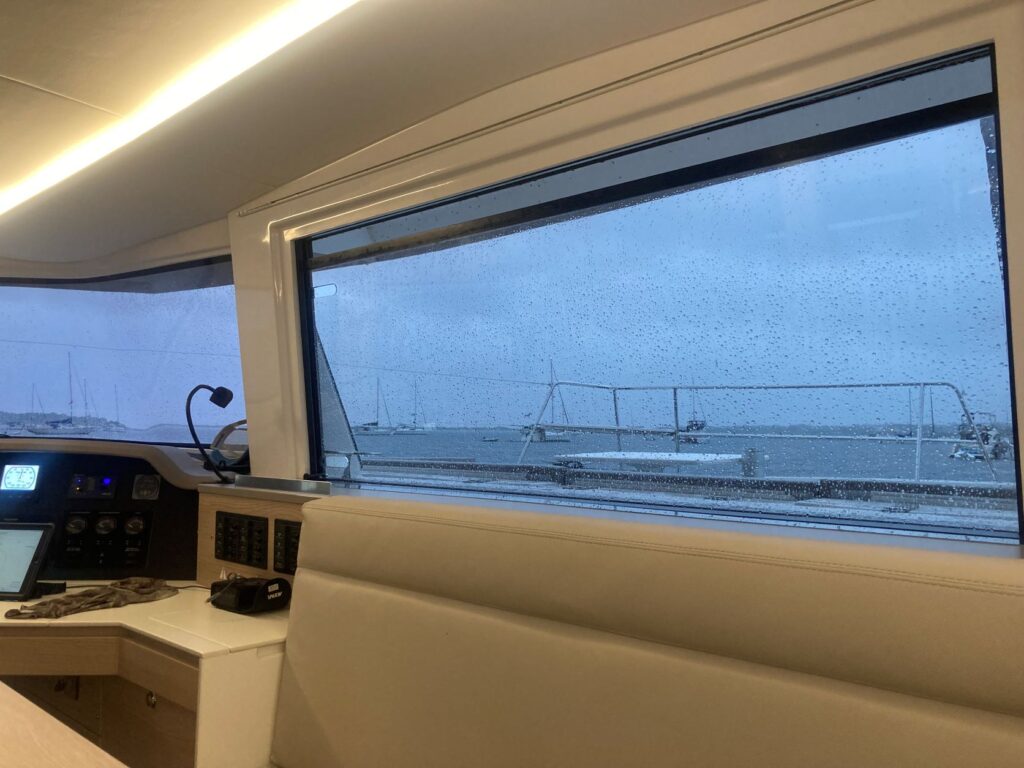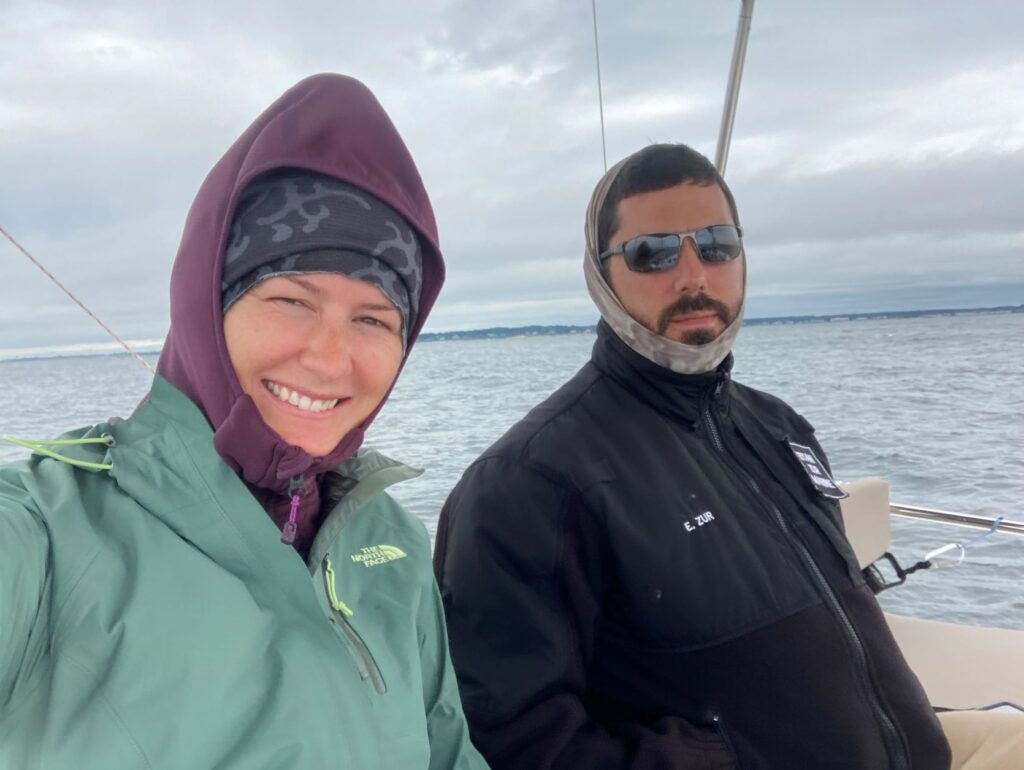After a week of day sailing, we departed Westport to meet the charter family in Newport in a couple days. We departed the marina in the morning and made our way along the Long Island Sound with plans of anchoring overnight at Block Island, Rhode Island. Having heard so many good things about Block Island, I was excited to finally see it and hoped the stormy weather wouldn’t dampen our time there.
The rain started a couple hours into the trip and we began to miss the protection of the enclosed pilot house on the motor yacht. Without a dodger, we had no protection from the wind and rain while sitting up at the helm. The rain started to get so bad that Eitan began steering from the navigation station inside using just the autopilot controls. Being the safety conscious captain that he is, he would normally never do this because he can’t control the throttles or steer in an emergency situation, like when a crab pot suddenly appears at the bow. But, considering neither of us had any foul weather gear and there wasn’t much traffic out, we opted for the protection of the cabin this time.
Things were quite comfortable until we entered into the Block Island Sound and lost the protection from Long Island. The wind and swell were coming from the south, causing us to bob around with the occasional boom of a wave slapping the bottom of the boat between the pontoons, known as a “cat slap”. The motion of a catamaran over swells is quite different than on a monohull. I had always thought catamarans were known for their stability, since they can’t heel, but I was surprised to experience a jerky motion as the boat kind of galloped over the waves. The last hour of the trip was pretty bumpy and we were relieved to enter the channel at Block Island. Being the middle of the week and with such wet weather, we anticipated an open anchorage, but were surprised by the hundreds of boats in the Great Salt Pond. Eitan had been there for the 4th of July last year and assured me it could be much more crowded, but to me, it was probably the most crowded anchorage I had ever seen!
Eitan scoped the limited anchorage spots as I prepared to drop the anchor in the pouring rain. Up until this point, we had only anchored in shallow waters with this boat and weren’t too certain at the amount of rode we had. The “rode” is the length of chain and rope connected to the anchor and ideally you have enough to put out at least 5 times the depth reading, ideally more in case the anchor drags due to strong winds or current. Well, it was already windy and the only open spots in the anchorage were no less than 35 feet, meaning we would need at least 175 feet of rode. By our best guess, we estimated we probably had about 100 feet of chain connected to another 50 feet of rope, so only 150 feet of rode total, no bueno.
Eitan instructed me to run out all the chain to see if we could get the anchor to hook on the bottom. Once at the end, it seemed the anchor had landed upside down and we didn’t catch the bottom at all, drifting backwards with the outgoing current. I started to pull the anchor up to reset, when suddenly the windlass jammed. The chain had twisted in the locker and backed up all the way to the windlass motor, I let a little chain out in an effort to alleviate the problem so I could knock over the pileup in the chain locker below. In doing so, the chain jumped the windlass track and began free flowing out of the boat. I stood there frozen as I prayed the end of the rode was attached to the boat somehow and we weren’t about to lose the only anchor and rode onboard.
I wasn’t sure how to stop it but I knew not to put my fingers anywhere between the chain and the boat. Eitan was quick thinking and grabbed a boat hook to put enough pressure on the rode to slow it down and hop it back into the track. The entire length of the chain had already gone out and it was now down to the rope, which I discovered was luckily attached to the boat. Since the windlass track is meant for the chain, I was having a hard time getting enough traction on the rope, but managed to get it up slowly. Finally, I got to the point where the rope was spliced to the chain and quite thick, causing it to jump the windlass track again. I was able to stop the free flow this time and get it back on the track. It took two people to finally get the splice over the windlass, one person pulling the rope from inside the locker and the other putting enough pressure on the splice to prevent it from jumping off. All while we are not secured to the bottom and Eitan having to run back and forth from the helm to drive us forward.
We finally got the anchor up and Eitan repositioned us farther in this time and a little shallower. I dropped the anchor once more and waited for the feel of the anchor hooking on the bottom. We still weren’t holding and we needed to reposition AGAIN. At this point, we were both completely soaked from the pouring rain and I tried to convince Eitan to call into the harbormaster and get us a mooring ball. Not only were our anchor attempts unsuccessful, I don’t know how either of us could sleep peacefully knowing how crowded the anchorage was and that the storm would continue into the next day. Eitan said we should give it one more try, and I guess the third time’s a charm. We finally hooked on the bottom.
As soon as we were secured, Eitan ran inside to fire up the generator and blast the heaters. We were drenched and changed out of our wet clothes, then put on some hot water for tea. The rain continued throughout the afternoon and into the next day. Despite the rough start to our arrival, we had a cozy time inside watching Netflix and eating pasta for dinner. It was still a little difficult to sleep at night with the pounding rain and howling wind, but luckily, we were holding well and didn’t moved at all. Unfortunately, it rained until we were ready to depart the next day and I never really got to see Block Island. Hopefully one day we will make it back and be blessed with better weather!




